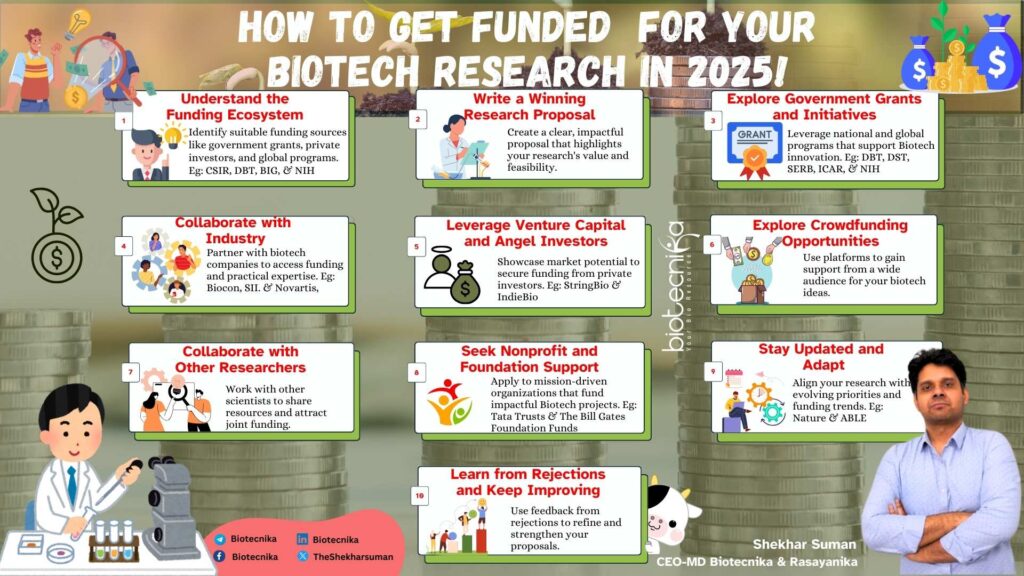Biotech Research Funding 2025 – How to Get Funded
Karan was a PhD research scholar at a leading university. After working day and night with his heart and soul, he developed extraordinary research on an instrument that utilizes 3D printing for regenerating human tissues and organs. He approached various investors to secure funding. His research was turned down multiple times, and frustrated, he almost gave up. For one last time, he gathered his courage and met with his investors. During his funding pitch to the investors, he shared his 7-year-old daughter’s story, suffering from Cardiomyopathy. Karan expressed the efforts and need for a heart transplant and emphasized that if technologies like this could advance in this world, then many lives could improve and be saved. Moved by Karan’s pitch and personal connection, the investors shook hands and agreed to fund his research. Years later, Karan’s firm has a patent for 3D-printed organ technology and provides services to top healthcare facilities. Let’s remember that in Biotechnology, securing decent funding frequently goes beyond Biotechnology and Science and is more about the pitch and the story.
Karan’s funding journey shows the importance of dedication, persistence, and hard work. If you are an enthusiastic researcher looking for funds, then this article is your funding guide. This will help you secure the best funding for your innovative Biotechnology research. All the best for your funding!
Biotech Research Funding 2025
- Understand the Funding Ecosystem
There are numerous Biotechnology funding sources, such as government and private grants, crowdfunding, as well as Non-Governmental Organization (NGO) funds. Knowing where to ask for support is the key to the right opportunities. Understanding these funding sources is the first step towards innovation and aligning with the right funding authorities.
Indian funding bodies such as the Council of Scientific and Industrial Research (CSIR) and the Department of Biotechnology (DBT) fund innovative research projects associated with Agriculture, Healthcare, as well as sustainable resolutions. National programs such as the Biotechnology Ignition Grant (BIG) are introduced for early-stage innovators in India. The National Institutes of Health (NIH) in the USA or Horizon Europe fund research with a prime focus on societal impact and innovation.
Biotech Research Funding 2025
Key Insights:
- Identify funding priorities: Focus on trending innovative ideas such as affordable diagnostics, green energy solutions, Synthetic Biology, precision agriculture, Gene Editing, as well as AI-driven Drug Discovery.
- Use online portals: Platforms like Grants.gov (USA), DBT’s eProMIS (India), as well as CORDIS (EU) list current research and funding opportunities.
- Complex System and competition: Navigating through numerous funding bodies with different timelines, criteria, as well as application procedures can be tiresome. The government as well as private sector grants, are highly competitive.
- Write a Winning Research Proposal
A research proposal that is well-written, easy to understand, and clear is a golden ticket to acquire funding. It should be written in such a way that it elaborately explains the significance, objectives, methodology, as well as the outcome of the research. Writing a winning proposal requires showcasing complex thoughts with clarity and in a structured way. Your proposal is the first pitch to the funders and investors, and it should emphasize the significance, feasibility, as well as impact on humankind and the environment.
Key Insights:
- Clear and concise research proposal: In your research proposal, avoid using complex, non-scientific words and jargon. The reviewers reviewing your research proposal can be from a general Science background and may not have expertise in your field of research.
- Justify your budget: Plan the budget and explain each expense’s impact on the research project.
- Impactful opening statement: The opening remarks of the research project should be robust and impactful. You should explain the central vision and inspiration of the research and its local as well as global market impact.
- Utilise visuals: Diagrams, flowcharts, timelines, as well as budgets make complex ideas easier to understand.
- Balance Scientific Depth: Maintain the right balance between the research’s technical details and reading comprehension.
- Utilize Government Grants and Initiatives
One of the prime sources of funding for Biotechnology professionals and scholars is government funds, especially in developing countries such as India. In India, funding authorities like DBT and DST provide support. These grants connect the research visions with national and global priorities. They are highly competitive, so connections and awareness increase the chances for successful funding. Government grants are the backbone of Life Sciences and Biotechnology research funding as well as support fundamental research and commercialization.
Grants:
- DBT’s Biotechnology Industry Research Assistance Council (BIRAC): Supports startups and innovators.
- Indian Council of Agricultural Research (ICAR): They focus on Agricultural Biotechnology.
- Science and Engineering Research Board (SERB): They focus on innovative and futuristic scientific research.
- NIH: Funds research in public health and Biomedical Sciences.
- Horizon Europe: Promotes interdisciplinary projects, including Biotechnology innovation.
Key Insights:
- Customize the research proposal: Align the research’s vision with the investor/funder’s goals. Indian grants often give importance to research focusing on sustainable agriculture as well as affordable healthcare.
- Seek institutional support: Research centers and universities in India provide mentorship and grant-writing assistance.
- Bureaucratic Hurdles: Government grants often require extensive documentation and compliance with bureaucratic processes, which can delay the approval process.
- Lengthy process: The review as well as the decision-making process for government grants, makes it difficult to stay focused on the research in the meantime.
- Collaborate with Industry
Industry partnerships offer funding, resources, as well as practical applications for your research proposal. Having strong industry collaborations increases your research’s vision as well as commercial potential, and aids in new avenues for funding. Align your research with what the public and industry need. Private companies invest in research that aligns with their business vision and goals. Collaborations can provide not just funding but also access to market insights and advanced facilities.
In India, Biocon, Serum Institute of India, and Bharat Biotech are known for supporting innovative Biotechnology and Life Science research, especially Vaccines and Biopharmaceuticals. Companies like Novartis and Bayer invest majorly in partnerships with research labs to develop new therapeutics and technologies globally.
Key Insights:
- Network effectively: Attend Biotech events such as India Bio or BioAsia to connect with industry leaders.
- Align with business goals: Show how your research supports their objectives, such as reducing production costs or addressing unmet medical needs.
- Aligning with Industry Needs: Biotech research should showcase feasible commercial applications that attract industry partners.
- Intellectual Property (IP) Concerns: Negotiating terms related to intellectual property rights can be challenging, especially when academic institutions and industries have different priorities.
- Balancing Academic and Commercial Goals: Maintaining academic integrity while meeting commercial goals can lead to conflicts, mainly when industry expectations differ from academic objectives.
Biotech Research Funding 2025
- Leverage Venture Capital and Angel Investors
Venture capital (VCs) and angel investors provide crucial funding for high-risk, high-reward Biotech projects. To attract investors, you need a strong business plan that shows market potential. Be prepared to give up equity in exchange for funding. If your research has commercial potential, VCs and angel investors are worth approaching. These funders are especially interested in projects with high scalability and market impact.
Startups like String Bio and Bugworks have attracted funding from Indian and global investors. Firms like IndieBio and Y Combinator are accelerators that provide funding and mentorship for early-stage Biotechnology startups.
Key Insights:
- Business plan development: Investors want to see a clear commercialization strategy.
- Highlight market potential: Use data to show the demand for your innovation, such as a booming market for alternative proteins in India and globally.
- Join incubators: India’s C-CAMP and IKP Knowledge Park provide mentorship and seed funding to Biotechnology innovators.
- High Expectations for Returns: Venture capitalists often expect rapid progress and significant returns on investment, which may not align with the long-term nature of many Biotechnology projects.
- Lack of Commercial Viability: If the research doesn’t have a clear route to market or lacks initial proof of concept, it may struggle to attract investors.
- Investor Risk: Many investors in Biotechnology are risky, especially for high-cost, high-risk projects that might take years to yield results.
- Explore Crowdfunding Opportunities
Crowdfunding platforms aid researchers in raising funds from the public, especially for projects having a societal impact. It requires engaging and clear communication to connect with potential investors/funders. It is effective for small capital and helps build a community around the field of your research. They help secure funding and build public interest in your work. Platforms such as Experiment.com, ImpactGuru, and Ketto are ideal for early-stage or niche projects. Globally, campaigns for projects like coral reef restoration or rare disease research have thrived on crowdfunding platforms.
Key Insights:
- Story: Explain with conviction how your research work would solve real-world problems.
- Visuals: Visuals such as infographics, charts, diagrams, photos, and videos captivate potential investors and make them easily comprehendible.
- Public Perception: Many Biotechnology researches are complex and challenging to explain in a way that connects with the public, which can hinder crowdfunding efforts.
- Limited Funding capital: Crowdfunding platforms generate small capital, which may not be sufficient for large-scale research projects.
- Collaborate with Other Researchers
Working with other scientists and researchers strengthens your proposals as well as expands your expertise. Collaborative research projects lead to better quality research proposals along with diverse perspectives. This attracts the funders and increases the opportunities for new funding. It enhances your research proposal’s scope as well as credibility. Collaborating with Scientific experts from diverse fields can strengthen your research as well as increase your chances of the right funding.
Key Insights:
- Search for collaborators: Platforms such as India’s Vidwan database and ResearchGate can help you network with Scientific experts from diverse fields.
- Highlight synergy: Emphasize how collaboration improves your research project’s impact and feasibility.
- Different Goals and Expertise: Collaborators could have varying visions for the research project, which could lead to conflicts in the methodology and vision of the research. Differences in technical knowledge and skill sets among collaborators complicate the research process as well as the writing of grant proposals.
- Communication and Coordination: Working with a diverse group challenges decision-making and communication. This results in slow progress and difficulty in coming up with a unified and unique research proposal.
- Seek Nonprofit and Foundation Support
Nonprofits and foundations provide grants for research that aligns with their missions. These funds often have fewer restrictions than government grants. Align your research goals with the foundation’s mission to increase your chances of securing funding. Nonprofits and foundations often fund research that aligns with their mission, such as improving public health or addressing environmental issues.
- India: Tata Trusts and Azim Premji Foundation support projects in healthcare, rural development, and education.
- Global: The Bill & Melinda Gates Foundation funds research on vaccines and global health.
Key Insights:
- Align with their mission: Tailor your proposal to reflect the organization’s goals, such as combating malnutrition in rural India.
- Focus on impact: Explain how your research benefits underserved communities.
- Narrow Focus Areas: Many nonprofit organizations have a specific mission or focus area, which can limit the scope of the research that qualifies for funding.
- Smaller Grants: Nonprofits may offer smaller grants compared to government or venture capital funding, limiting the resources available for large-scale research.
- Rigid Reporting Requirements: Foundations may require frequent and detailed progress reports, adding additional administrative work to the research project.
- Stay Updated and Adapt
Biotechnology research and development is exponentially evolving, and staying updated on new trends as well as funding resources are highly essential. Adapt your research focus so that it aligns with changing priorities, and make sure not to miss out on relevant funding opportunities. Regularly network and engage with the latest developments in your field. Biotechnology evolves rapidly, and funding trends shift accordingly. Staying informed helps you align your research with emerging opportunities.
Fields such as Bioinformatics, climate-resilient crops, and Synthetic Biology are quite popular for research in India. Globally, fields such as mRNA and AI-driven Drug Discovery technology are gaining huge investments.
Key Insights:
- Biotechnology and Life Science journals: Subscribe and follow popular journals like the Indian Journal of Biotechnology and Nature Biotechnology to enhance your research and information.
- Professional groups: Indian organizations such as the Association of Biotechnology-Led Enterprises (ABLE) offer insights into funding opportunities.
- Evolving Landscape: Biotechnology is rapidly evolving with futuristic advancements in technology and methods. You should adapt and stay updated with the latest developments.
- Identify Opportunities: It’s not necessary that every emerging funding source will align with your research. Hence, browse the options of investors and funding sources to identify the right fit.
- Adapt to Trends: Biotechnology research often requires a long timeline, but funders’ interests may shift in response to new trends, requiring researchers to pivot quickly.
- Learn from Rejections
Rejections are a part of the funding process, although they offer valuable feedback. Utilize rejections to redefine your research proposals and make adjustments as well as improvements. Willingness to adapt and persistence would eventually lead to funding success. Rejection is a part of every researcher’s journey. Treat it as an opportunity to refine your approach and improve your proposal.
Key Insights:
- Seek feedback: Indian and global funding agencies often provide reasons for rejection—use them to improve.
- Diversify applications: Don’t rely on a single funding source. Apply to multiple programs simultaneously.
- Stay Persistent: Remember that many researchers and scientists face rejection at some point. Persistence, determination, as well as the willingness to adapt based on constructive feedback, are essential in attaining funds.
- Setbacks: Rejection can be disheartening, especially after months or years of determination and hard work. But you need to stay positive, determined, and enhance your research.
Biotech Research Funding 2025 – How to Get Funded
Securing funding in Biotechnology is quite difficult, but it’s paved with opportunities for those who have hope and persevere. By understanding the funding process, drafting extraordinary proposals, and leveraging the power of innovation and collaboration, a capable researcher can turn even the boldest ideas into reality.
Biotechnology is the leading field in addressing critical challenges in Healthcare, Agriculture, and the Environment worldwide. The need for transformative solutions has never been greater, and the resources to support them are within reach for those willing to explore, adapt, and connect. With the right strategy and resilience, your work could become part of the next wave of breakthroughs shaping the future of science and humanity. Keep innovating, keep striving, and let your research become the foundation for a better tomorrow.
Remember, each step—whether a success or setback—adds to your growth as a researcher. Stay informed, stay connected, and most importantly, stay committed to your vision. With the right approach, your research can shape the future of Biotechnology and make a lasting impact.
Biotech Research Funding 2025






































